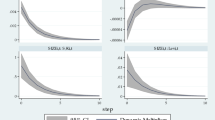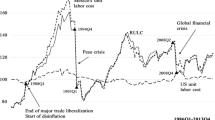Abstract
This paper empirically investigates the impact of exchange rate shocks on capital stock adjustment in the Japanese industry. An intertemporal optimization model is developed, in which an individual corporation in an open economy adjusts its capital stock according to Tobin’s q. By explicitly considering the marginal q, the transmission mechanism from real exchange rate shocks to investment dynamics is examined based on the Vector Autoregressive model. Empirical evidence suggests that the depreciation of the Japanese yen increases the expected profitability of the firm and stimulates investment, especially in the machinery sector.
Similar content being viewed by others
References
Abel, A. B. and O. Blanchard (1986) “The Present Value of Profits and Cyclical Movements in Investment”, Econometrica, Vol. 54, No. 5, pp. 249–273.
Asako, K. and M. Kuninori (1989) “The Theory of Equipment and Empirical Evidence in Japan”, in H. Uzawa, ed., The History of Accumulation and Growth in Japanese Economy, Tokyo: University of Tokyo Press, pp. 151–182. (In Japanese.)
Bank of Japan (2000) “Exchange Rate Volatility and Export Behaviour”, Bank of Japan Monthly, March. (In Japanese.)
Blanchard, O. J. and D. Quah (1989) “The Dynamic Effects of Aggregate Demand and Supply Disturbances”, American Economic Review, Vol. 79, No. 4, pp. 655–673.
Blanchard, O. J. and W. Watson (1986) “Are Business Cycle All Alike?”, in R. Gordon, ed., The American Business Cycle: Continuity and Change, Chicago: University of Chicago Press, pp. 123–179.
Brock, P. L. (1988) “Investment, the Current Account, and the Relative Price of Non-Traded Goods in a Small Open Economy”, Journal of International Economics, Vol. 24, No. 3, pp. 235–253.
Campa, J. and L. S. Goldberg (1995) “Investment in Manufacturing, Exchange Rates and External Exposure”, Journal of International Economics, Vol. 38, No. 3, pp. 297–320.
Campa, J. and L. S. Goldberg (1999) “Investment, Pass-Through and Exchange Rates: A Cross Country Comparison”, International Economic Review, Vol. 40, No. 2, pp. 287–314.
Chida, R. (1995) The Export Behaviour under the Imperfect Competition, Economic Bulletin, Tokyo International University, Vol. 13, pp. 19–41. (In Japanese.)
Cochrane, J. (1988) “How Big Is the Random Walk in GNP?”, Journal of Political Economy, Vol. 96, No. 5, pp. 893–920.
Eichengreen, B. and M. Hatase (2007) “Can a Rapidly-Growing Export-Oriented Economy Smoothly Exit an Exchange Rate Peg? Lessons for China from Japan’s High-Growth Era”, Explorations in Economic History, Vol. 44, No. 3, pp. 501–521.
Erickson, T. and T. Whited (2000) “Measurement Error and the Relationship between Investment and q”, Journal of Political Economy, Vol. 108, No. 5, pp. 1027–1057.
Gali, J. (1992) “How Well Does the IS-LM Model Fit Postwar U.S. Data?”, Quarterly Journal of Economics, Vol. 107, No. 2, pp. 709–738.
Goldberg, L. S. (1993) “Exchange Rates and Investment in United States Industry”, Review of Economics and Statistics, Vol. 32, No. 4, pp. 575–588.
Gomes, J. (2001) “Financing Investment”, American Economic Review, Vol. 91, No. 5, pp. 1263–1285.
Harchaoui, T., F. Tarkhani and T. Yuen (2005) “The Effects of the Exchange Rate on Investment: Evidence from Canadian Manufacturing Industries”, Bank of Canada Working Paper, 2005–22.
Hayashi, F. (1982) “Tobin’s Marginal q and Average q: A Neoclassical Interpretation”, Econometrica, Vol. 50, No. 1, pp. 213–224.
Institute for Social Engineering (1976) Research on Advanced Use of Report of Financial Statements of Incorporated Business. (In Japanese.)
Kruguman, P. R. (1987) “Pricing to Market When the Exchange Rate Changes”, in S.W. Arndtand and J.D. Richardson, eds, Real Financial Linkages among Open Economies, Cambridge MA: MIT press, pp. 49–70.
Matsubayashi, Y. (2006) “Structural and Cyclical Movements of the Current Account in Japan: An Alternative Measure”, Japan and the World Economy, Vol. 18, No. 4, pp. 545–567.
Miyagawa, T. (1997) “The Development of Corporate Investment Theory and the Variety of Empirical Study”, in K. Asako and M. Otaki, eds, Macroeconomic Dynamics, Tokyo: Tokyo University Press, pp. 9–56. (In Japanese.)
Miyagawa, T. and Y. Takeda (1994) “Investment and the Persistence of Japanese Trade Surplus”, Japan Center for Economic Research Discussion Paper, No. 34.
Murphy, R. G. (1993) “Stock Prices, Real Exchange Rates and Optimal Capital Accumulation”, IMF Staff Papers, No. 36, pp. 102–129.
Nucci, F. and A. F. Pozzolo (2001) “Investment and the Exchange Rate: An Analysis with Firm-Level Panel Data”, European Economic Review, Vol. 45, No. 5, pp. 259–283.
Ogawa, K. (2000) “Transmission Mechanism of Monetary Policy”, in H. Osano and Y. Honda, eds, Modern Finance and Policy, Tokyo: Nihon Hyoronsha pp. 74–110. (In Japanese.)
Ogawa, K. and S. Kitasaka (1998) Asset Market and Business Cycles, Tokyo: Nihon Keizai Shinbunsya. (In Japanese.)
Ogawa, K. and S. Kitasaka (1999) “Market Valuation and the q Theory of Investment”, Japanese Economic Review, Vol. 50, No. 2, pp. 191–211.
Otaki, M. and K. Suzuki (1986) “Tobin’s q and the Fluctuations of Profit Rate and Discount Factor”, Kokumin Keizai, No. 152, pp. 23–39. (In Japanese.)
Schiantarelli, F. and D. Geogoutsos (1990) “Monopolistic Competition and the q Theory of Investment”, European Economic Review, Vol. 34, No. 5, pp. 1061–1078.
Shapiro, M. and M. W. Watson (1988) “Sources of Business Cycle Fluctuations”, NBER Macroeconomic Annual, Vol. 3, pp. 111–148.
Shioji, E. and Y. Uchino (2009) “Do Pass-Through of Exchange Rate and Oil Price Variation Change?”, Bank of Japan Discussion Paper Series, 09-J-08.
Sims, C. A. (1986) “Are Forecasting Models Usable for Policy Analysis?”, Quarterly Review, Vol. 10, Federal Reserve Bank of Minneapolis, pp. 2–16.
Takenaka, H. (1993) Internationalization of Japanese Economy and Corporate Investment, Tokyo: Nihon Hyoron sya. (In Japanese.)
Tokui, J. and T. Miyagawa (1991) “Price Competitiveness and the Investment Behaviour in Japanese Manufacturing Industries”, Japan Development Bank Discussion Paper Series9105.
Tokui, J. and K. Suzuki (1990) “Exchange Rate Adjustment and International Competitiveness in Japan and U.S.”, in S. Kinoshita, ed., The Development of Pacific Rim Countries and Structural Adjustment, Tokyo: Nagoya University Press, pp. 283–322. (In Japanese.)
Yoshikawa, H. (1995) Macroeconomics and the Japanese Economy, Tokyo: Oxford University Press.
Author information
Authors and Affiliations
Rights and permissions
About this article
Cite this article
Matsubayashi, Y. Exchange Rate, Expected Profit and Capital Stock Adjustment: Japanese Experience. JER 62, 215–247 (2011). https://doi.org/10.1111/j.1468-5876.2010.00516.x
Accepted:
Published:
Issue Date:
DOI: https://doi.org/10.1111/j.1468-5876.2010.00516.x




